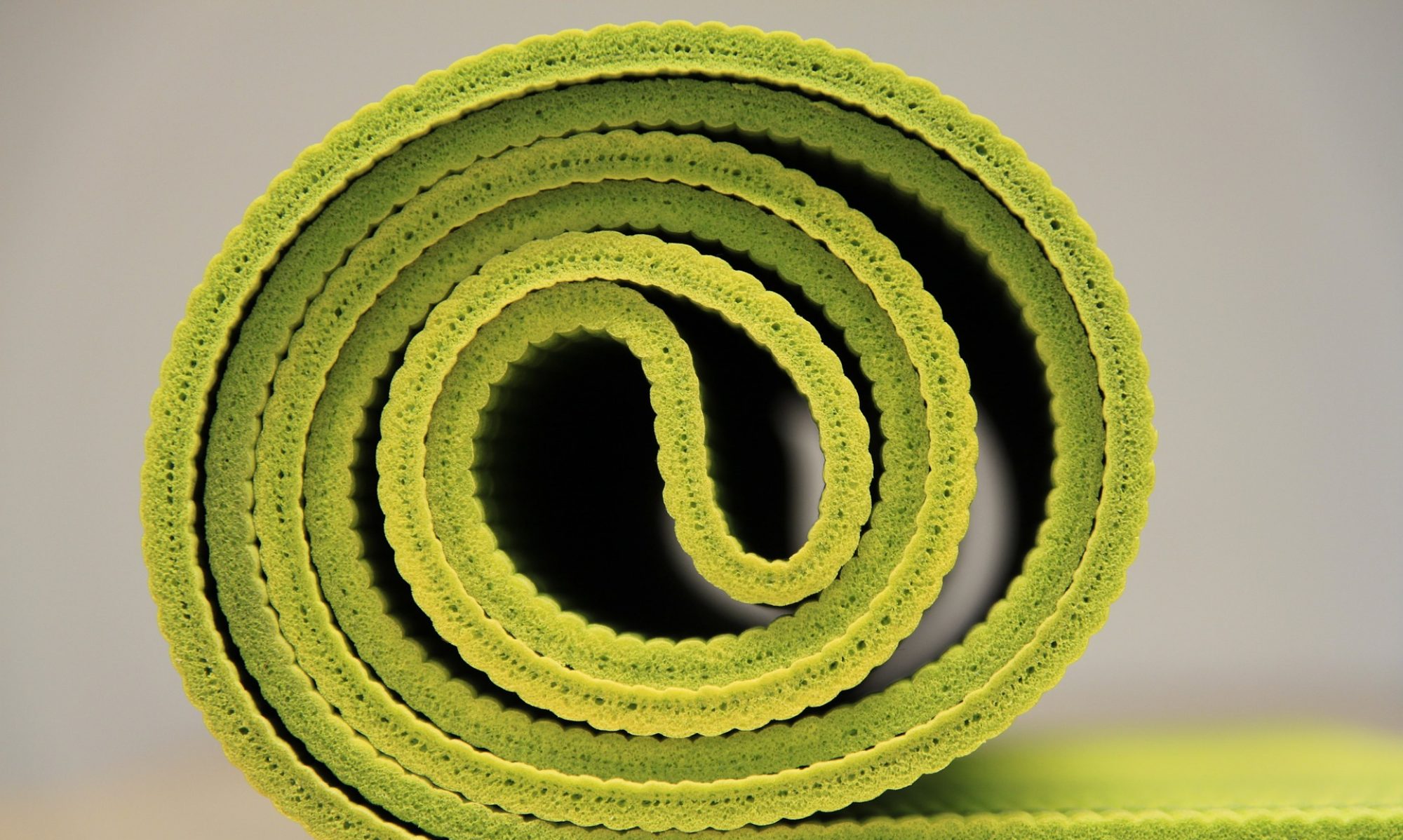Once we are attending a yoga class regularly, we often feel the pull of the yoga mat between classes. Shall I, shall I not, unroll my mat? Will I know what to do once I have unrolled it?
Even experienced yoga practitioners occasionally unroll their mats and ponder where to begin.
Here are a few thoughts and ideas to get you started.
Equipment
Firstly, if you don’t have a mat – source one. A friend may well have a spare, ask around. Mats will often tolerate a light machine wash: hang it over the banister to dry. Mine dries overnight.
There is a vast array of mats on the market: cheap and cheerful, eco-friendly and extravagant. Buy one that rolls up.
Yoga Matters is a good place to start. Alternatively a local sports shop may have some mats you could look at to get an idea of what you are buying. A 4mm thick mat is about right. More than that is a bit squishy for standing poses.
A cotton or wool blanket would be useful. Put it under your head when you are supine, sit on it or support a knee with it and so on – just as you would in class. A towel would be a good interim substitute for a blanket. Fleece throws seem a good idea, but are slippery and tend to unfold in use. Aim for something firm and supportive.
Again for belts, bricks and blocks – ask around. A friend may be only too happy to lend or gift you some equipment. A neck tie or dressing gown belt could substitute for a yoga strap in the short term.
Place
So, now we have the basics, we also need a place to store them, and a place to practice! This can be very challenging in a busy household. I am fortunate enough to have a dedicated yoga room, as my family have flown the nest. When everyone is home, I unroll my mat in the kitchen, or the hall. A yoga mat is approximately 180 cm by 60 cm.
In the kitchen the work top becomes a raise, and as my arms are above the work surface I have room to extend and turn. The hall is narrow, but I can use the walls. When I visit my daughter, I use a half mat.
For safety, wide legged poses need the full length of the mat, but many poses can be done in a smaller space, or without a mat. I have a friend who practises on family camping holidays. Her only specification is that she must have enough height in the tent to perform her head stand. Be flexible – find a space that you can call your yoga home, clear it of clutter, dust or toast crumbs, and unroll your mat.
To store your equipment, lay your blanket on the mat with your “strap” and roll it all up together. Or use the strap to secure the mat roll. It could stand in the corner, under the bed or under the sofa. Out of the way, but easy to grab when you have a spare 10 to 15 minutes.
Time
In this next week, observe your time. Do you have a spare half an hour once a week for your yoga? You may only spend 10 to 15 minutes of that time on your mat, but you need time to gather your thoughts, pop on some comfy clothes, and unroll your mat.
Only you can find that time. However, part of this may be to ask others to support us. For many, yoga practice is a spontaneous pose struck at an opportune moment. You may suddenly get the urge to move into Vrksasana (tree pose) whilst waiting for the kettle to boil, or stretch into Adho Mukha Svanasana (downward facing dog), or simply sit crossed legged whilst watching the television. All these are good, but 15 minutes of dedicated time, carved out from a busy schedule, is a luxury to aim for, which will reap rewards over time.
“A great boon of yoga, even for relative beginners, is the happiness it brings, a sense of self-reliant contentment.” BKS Iyengar, Light on Yoga
Now we have both place and time, plus a reason to practise.
The following are two short sequences to get you started. Both start and end in the same way – which will be very familiar from class. Begin with some breath work and chanting in a cross legged position – end with Savasana.
When you have these sequences established in your life, once or twice a week, ask your Iyengar teacher to suggest something different.
To begin: Swastikasana, or crossed legged, as able. Focus on your breath and begin your chant. Don’t skip this bit – it will draw you from the world to your practice. Exhale the day, inhale your practice.
Sequence 1 – standing poses
Tadasana, Utkatasana, Uttanasana to wall or raise (feet hip width), Adho Mukha Svanasana, Trikonasana, Virabhadrasana 2, Adho Mukha Svanasana, Adho Mukha Virasana.
(Repeat sequence if you have time. Alternatively, you could ring the changes by raising your arms in Tadasana, or moving from Utkatasana to Malasana.)
OR
Sequence 2 – restorative
Adho Mukha Virasana, Adho Mukha Svanasana, Viparita Karani
If you have time to spare – string the two sequences together.
To end your practice:
Savasana, focused breathing. Savasana.
Always allow time for Savasana.
“As you are lying on the earth in Savasana, do you not, when the posture is harmonious and balanced, feel both present and formless? When you feel present, yet formless, do you not feel an absence of specific identity?
You are there, but who is there?” BKS Iyengar Light on Life
And there we have it: time, place, purpose and an itinerary . Now unroll your mat, sit on it, and let the magic begin . . .
Let me know how you get on. Fiona

